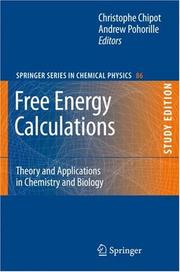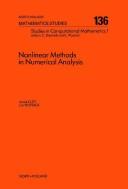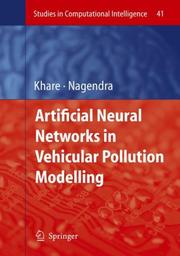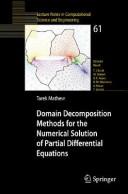| Listing 1 - 7 of 7 |
Sort by
|
Book
ISBN: 9783540264033 1280337958 9786610337958 3540264035 Year: 2006 Publisher: Berlin, Heidelberg Springer-Verlag Berlin Heidelberg
Abstract | Keywords | Export | Availability | Bookmark
 Loading...
Loading...Choose an application
- Reference Manager
- EndNote
- RefWorks (Direct export to RefWorks)
The first and most exhaustive work of its kind devoted entirely to the subject, Large Eddy Simulation presents a comprehensive account and a unified view of this young but very rich discipline. LES is the only efficient technique for approaching high Reynolds numbers when simulating industrial, natural or experimental configurations. The author concentrates on incompressible fluids and chooses his topics in treating with care both the mathematical ideas and their applications. The book addresses researchers as well as graduate students and engineers. The second edition was a greatly enriched version motivated both by the increasing theoretical interest in LES and the increasing number of applications. Two entirely new chapters were devoted to the coupling of LES with multiresolution multidomain techniques and to the new hybrid approaches that relate the LES procedures to the classical statistical methods based on the Reynolds-Averaged Navier-Stokes equations. This 3rd edition adds various sections to the text such as a careful error analysis of filtered density function models and multiscale models. It also contains two new chapters dealing with the mathematical representations of LES and the prediction of active and passive scalar dynamics, which are of considerable interest for engineering and geophysical modeling. The part on geophysical flow has much to offer on a critical current issue. To quote from the foreword to the third edition written by Charles Meneveau: "... this meticulously assembled and significantly enlarged description of the many aspects of LES will be a most welcome addition to the bookshelves of scientists and engineers in fluid mechanics, LES practitioners, and students of turbulence in general.".
Numerical analysis --- Space research --- Astrophysics --- Mathematical physics --- Gases handling. Fluids handling --- Computer. Automation --- astrofysica --- informatica --- wiskunde --- algoritmen --- fysica --- ruimte (astronomie) --- numerieke analyse --- vloeistoffen --- Turbulència --- Remolins (Mecànica de fluids) --- Physics. --- Continuum physics. --- Fluid mechanics. --- Fluids. --- Computational intelligence. --- Computer mathematics. --- Numerical and Computational Physics, Simulation. --- Classical and Continuum Physics. --- Engineering Fluid Dynamics. --- Fluid- and Aerodynamics. --- Computational Intelligence. --- Computational Science and Engineering. --- Models matemàtics --- Turbulence --- Eddies --- Mathematical models.
Book
ISBN: 9783642024757 9783642024740 3642024742 3642024750 Year: 2009 Publisher: Berlin, Heidelberg Springer Berlin Heidelberg
Abstract | Keywords | Export | Availability | Bookmark
 Loading...
Loading...Choose an application
- Reference Manager
- EndNote
- RefWorks (Direct export to RefWorks)
The aim of this book is to teach computer programming using examples from mathematics and the natural sciences. We have chosen to use the Python programming language because it combines remarkable power with very clean, simple, and compact syntax. Python is easy to learn and very well suited for an introduction to computer programming. Python is also quite similar to Matlab and a good language for doing mathematical computing. It is easy to combine Python with compiled languages, like Fortran, C, and C++, which are widely used languages for scientific computations. A seamless integration of Python with Java is offered by a special version of Python called Jython. The examples in this book integrate programming with applications to mathematics, physics, biology, and finance. The reader is expected to have knowledge of basic one-variable calculus as taught in mathematics-intensive programs in high schools. It is certainly an advantage to take a university calculus course in parallel, preferably containing both classical and numerical aspects of calculus. Although not strictly required, a background in high school physics makes many of the examples more meaningful.
Numerical analysis --- Computer. Automation --- informatica --- algoritmen --- numerieke analyse --- Programming --- informaticaonderzoek --- wiskunde --- computerbesturingssystemen --- programmeren (informatica) --- Computer science --- EPUB-LIV-FT LIVMATHE LIVSTATI SPRINGER-B --- Python (Computer program language). --- Computer science. --- Software engineering. --- Mathematics of Computing. --- Computational Science and Engineering. --- Programming Techniques. --- Software Engineering/Programming and Operating Systems. --- Numerical and Computational Physics, Simulation. --- Computer software engineering --- Engineering --- Informatics --- Science --- Python (Computer program language) --- 681.3*D3 --- 681.3*D3 Programming languages --- Programming languages --- Scripting languages (Computer science) --- Computer science—Mathematics. --- Computer mathematics. --- Computer programming. --- Physics. --- Natural philosophy --- Philosophy, Natural --- Physical sciences --- Dynamics --- Computers --- Electronic computer programming --- Electronic data processing --- Electronic digital computers --- Programming (Electronic computers) --- Coding theory --- Computer mathematics --- Mathematics

ISSN: 01726218 ISBN: 9783540384489 9783540736172 3540736174 1280745339 9786610745333 3540384472 3540384480 Year: 2007 Volume: v. 86 Publisher: Berlin, Heidelberg Springer-Verlag Berlin Heidelberg
Abstract | Keywords | Export | Availability | Bookmark
 Loading...
Loading...Choose an application
- Reference Manager
- EndNote
- RefWorks (Direct export to RefWorks)
Free energy constitutes the most important thermodynamic quantity to understand how chemical species recognize each other, associate or react. Examples of problems in which knowledge of the underlying free energy behaviour is required, include conformational equilibria and molecular association, partitioning between immiscible liquids, receptor-drug interaction, protein-protein and protein-DNA association, and protein stability. This volume sets out to present a coherent and comprehensive account of the concepts that underlie different approaches devised for the determination of free energies. The reader will gain the necessary insight into the theoretical and computational foundations of the subject and will be presented with relevant applications from molecular-level modelling and simulations of chemical and biological systems. Both formally accurate and approximate methods are covered using both classical and quantum mechanical descriptions. A central theme of the book is that the wide variety of free energy calculation techniques available today can be understood as different implementations of a few basic principles. The book is aimed at a broad readership of graduate students and researchers having a background in chemistry, physics, engineering and physical biology.
chemie --- Numerical analysis --- Computer. Automation --- algoritmen --- Statistical physics --- informatica --- Atomic physics --- Plasma physics --- Chemistry --- numerieke analyse --- General biophysics --- plasmafysica --- fysicochemie --- biofysica --- statistiek --- Physicochemistry --- fysica --- Gibbs' free energy --- Thermodynamics --- Thermodynamique --- General and Others --- Chemistry. --- Physical chemistry. --- Chemistry, Physical and theoretical. --- Physics. --- Atoms. --- Biophysics. --- Biological physics. --- Statistical physics. --- Dynamical systems. --- Theoretical and Computational Chemistry. --- Physical Chemistry. --- Numerical and Computational Physics. --- Statistical Physics, Dynamical Systems and Complexity. --- Atomic, Molecular, Optical and Plasma Physics. --- Biophysics and Biological Physics. --- Linear free energy relationship --- Computer simulation. --- Physical sciences --- Correlation analysis (Chemistry) --- Correlation equation (Chemistry) --- Free energy relationship, Linear --- Chemical reaction, Conditions and laws of --- Chemistry, Physical organic. --- Numerical and Computational Physics, Simulation. --- Complex Systems. --- Biological and Medical Physics, Biophysics. --- Chemistry, Physical organic --- Chemistry, Organic --- Chemistry, Physical and theoretical --- Biological physics --- Biology --- Medical sciences --- Physics --- Matter --- Stereochemistry --- Dynamical systems --- Kinetics --- Mathematics --- Mechanics, Analytic --- Force and energy --- Mechanics --- Statics --- Mathematical statistics --- Natural philosophy --- Philosophy, Natural --- Dynamics --- Chemistry, Theoretical --- Physical chemistry --- Theoretical chemistry --- Constitution --- Statistical methods

ISBN: 0444701893 9786611756284 1281756288 0080872476 9780444701893 9780080872476 9781281756282 Year: 1987 Volume: 136 1 Publisher: Amsterdam New York New York, N.Y., U.S.A. North-Holland Sole distributors for the U.S.A. and Canada, Elsevier Science Pub. Co.
Abstract | Keywords | Export | Availability | Bookmark
 Loading...
Loading...Choose an application
- Reference Manager
- EndNote
- RefWorks (Direct export to RefWorks)
While most textbooks on Numerical Analysis discuss linear techniques for the solution of various numerical problems, this book introduces and illustrates nonlinear methods. It presents several nonlinear techniques resulting mainly from the use of Padé approximants and rational interpolants.
Analyse numérique --- Numerical analysis --- Numerieke analyse --- 517.518.8 --- 519.6 --- 681.3*G11 --- 681.3*G12 --- Mathematical analysis --- Approximation of functions by polynomials and their generalizations --- Computational mathematics. Numerical analysis. Computer programming --- Interpolation: difference formulas; extrapolation; smoothing; spline and piecewise polynomial interpolation (Numerical analysis) --- Approximation: chebyshev; elementary function; least squares; linear approximation; minimax approximation and algorithms; nonlinear and rational approximation; spline and piecewise polynomial approximation (Numerical analysis) --- 681.3*G12 Approximation: chebyshev; elementary function; least squares; linear approximation; minimax approximation and algorithms; nonlinear and rational approximation; spline and piecewise polynomial approximation (Numerical analysis) --- 681.3*G11 Interpolation: difference formulas; extrapolation; smoothing; spline and piecewise polynomial interpolation (Numerical analysis) --- 519.6 Computational mathematics. Numerical analysis. Computer programming --- 517.518.8 Approximation of functions by polynomials and their generalizations --- Analyse numérique --- ELSEVIER-B EPUB-LIV-FT --- Mathematical analysis. --- Numerical analysis. --- 517.1 Mathematical analysis --- Analyse numérique. --- Series (mathematique) --- Equations non lineaires --- Sommation --- Approximation des solutions

ISBN: 9783540374183 3540374175 9786610700325 1280700327 3540374183 9783540374176 Year: 2007 Volume: 41 Publisher: Berlin, Heidelberg Springer-Verlag Berlin Heidelberg
Abstract | Keywords | Export | Availability | Bookmark
 Loading...
Loading...Choose an application
- Reference Manager
- EndNote
- RefWorks (Direct export to RefWorks)
Artificial neural networks (ANNs), which are parallel computational models, comprising of interconnected adaptive processing units (neurons) have the capability to predict accurately the dispersive behavior of vehicular pollutants under complex environmental conditions. This book aims at describing step-by-step procedure for formulation and development of ANN based VP models considering meteorological and traffic parameters. The model predictions are compared with existing line source deterministic/statistical based models to establish the efficacy of the ANN technique in explaining frequent dispersion complexities in urban areas. The book is very useful for hardcore professionals and researchers working in problems associated with urban air pollution management and control.
Air pollution. Air purification --- analyse (wiskunde) --- Computer. Automation --- robots --- toegepaste wiskunde --- Transport engineering --- numerieke analyse --- Mathematics --- Nature protection --- Engineering sciences. Technology --- Artificial intelligence. Robotics. Simulation. Graphics --- luchtverontreiniging --- ingenieurswetenschappen --- algoritmen --- transport --- Air --- Automobiles --- Neural networks (Computer science) --- Pollution --- Mathematical models --- Motors --- Exhaust gas --- Engineering mathematics. --- Artificial intelligence. --- Engineering. --- Environmental protection. --- Mathematics. --- Mathematical and Computational Engineering. --- Artificial Intelligence. --- Automotive Engineering. --- Atmospheric Protection/Air Quality Control/Air Pollution. --- Applications of Mathematics. --- Computational Intelligence. --- Math --- Science --- Environmental quality management --- Protection of environment --- Environmental sciences --- Applied ecology --- Environmental engineering --- Environmental policy --- Environmental quality --- Construction --- Industrial arts --- Technology --- AI (Artificial intelligence) --- Artificial thinking --- Electronic brains --- Intellectronics --- Intelligence, Artificial --- Intelligent machines --- Machine intelligence --- Thinking, Artificial --- Bionics --- Cognitive science --- Digital computer simulation --- Electronic data processing --- Logic machines --- Machine theory --- Self-organizing systems --- Simulation methods --- Fifth generation computers --- Neural computers --- Engineering --- Engineering analysis --- Mathematical analysis --- Applied mathematics. --- Automotive engineering. --- Air pollution. --- Computational intelligence. --- Intelligence, Computational --- Artificial intelligence --- Soft computing --- Air contaminants --- Air pollutants --- Air pollution --- Air pollution control --- Air toxics --- Airborne pollutants --- Atmosphere --- Contaminants, Air --- Control of air pollution --- Pollutants, Air --- Toxics, Air --- Air quality --- Atmospheric deposition --- Control --- Mathematical models. --- Artificial neural networks --- Nets, Neural (Computer science) --- Networks, Neural (Computer science) --- Neural nets (Computer science) --- Natural computation --- Autos (Automobiles) --- Cars (Automobiles) --- Gasoline automobiles --- Motorcars (Automobiles) --- Motor vehicles --- Transportation, Automotive --- Air - Pollution - Mathematical models --- Automobiles - Motors - Exhaust gas - Mathematical models
Book
ISBN: 9781848009868 9781848009851 1848009852 1849968101 9786611871390 1615830561 1281871397 1848009860 Year: 2008 Publisher: London Springer London
Abstract | Keywords | Export | Availability | Bookmark
 Loading...
Loading...Choose an application
- Reference Manager
- EndNote
- RefWorks (Direct export to RefWorks)
Failure Rate Modelling for Reliability and Risk focuses on reliability theory and, specifically, on the failure rate (the hazard rate, the force of mortality) modelling and its generalizations, on systems operating in a random environment and on repairable systems. The failure rate is one of the crucial probabilistic characteristics for a number of disciplines; including reliability, survival analysis, risk analysis and demography. Failure Rate Modelling for Reliability and Risk presents a systematic study of the failure rate and related indices, and covers a number of important applications where the failure rate plays the major role. Applications in engineering systems are studied, together with some actuarial, biological and demographic examples. Covering material previously available only in the journal literature, Failure Rate Modelling for Reliability and Risk provides a survey of this broad and interdisciplinary subject which will be invaluable to researchers and advanced students in reliability engineering and applied statistics, as well as to demographers, econometricians, actuaries and many other mathematically oriented researchers.
Production management --- statistische kwaliteitscontrole --- Computer. Automation --- Statistical physics --- numerieke analyse --- Engineering sciences. Technology --- kwaliteitscontrole --- algoritmen --- industriële statistieken --- EPUB-LIV-FT LIVINGEN SPRINGER-B --- System safety. --- Distribution (Probability theory. --- Engineering. --- Statistics. --- Quality Control, Reliability, Safety and Risk. --- Probability Theory and Stochastic Processes. --- Computational Intelligence. --- Statistics for Engineering, Physics, Computer Science, Chemistry and Earth Sciences. --- Statistical analysis --- Statistical data --- Statistical methods --- Statistical science --- Mathematics --- Econometrics --- Construction --- Industrial arts --- Technology --- Distribution functions --- Frequency distribution --- Characteristic functions --- Probabilities --- Safety, System --- Safety of systems --- Systems safety --- Accidents --- Industrial safety --- Systems engineering --- Prevention --- Quality control. --- Reliability. --- Industrial safety. --- Probabilities. --- Computational intelligence. --- Statistics . --- Intelligence, Computational --- Artificial intelligence --- Soft computing --- Probability --- Statistical inference --- Combinations --- Chance --- Least squares --- Mathematical statistics --- Risk --- Industrial accidents --- Industries --- Job safety --- Occupational hazards, Prevention of --- Occupational health and safety --- Occupational safety and health --- Prevention of industrial accidents --- Prevention of occupational hazards --- Safety, Industrial --- Safety engineering --- Safety measures --- Safety of workers --- System safety --- Dependability --- Trustworthiness --- Conduct of life --- Factory management --- Industrial engineering --- Reliability (Engineering) --- Sampling (Statistics) --- Standardization --- Quality assurance --- Quality of products --- System failures (Engineering) --- Failure time data analysis.

ISBN: 9783540772095 9783540772057 3540772057 354077209X 9786611512804 128151280X Year: 2008 Publisher: Berlin, Heidelberg Springer-Verlag Berlin Heidelberg
Abstract | Keywords | Export | Availability | Bookmark
 Loading...
Loading...Choose an application
- Reference Manager
- EndNote
- RefWorks (Direct export to RefWorks)
Domain decomposition methods are divide and conquer methods for the parallel and computational solution of partial differential equations of elliptic or parabolic type. They include iterative algorithms for solving the discretized equations, techniques for non-matching grid discretizations and techniques for heterogeneous approximations. This book serves as an introduction to this subject, with emphasis on matrix formulations. The topics studied include Schwarz, substructuring, Lagrange multiplier and least squares-control hybrid formulations, multilevel methods, non-self adjoint problems, parabolic equations, saddle point problems (Stokes, porous media and optimal control), non-matching grid discretizations, heterogeneous models, fictitious domain methods, variational inequalities, maximum norm theory, eigenvalue problems, optimization problems and the Helmholtz scattering problem. Selected convergence theory is included.
informatica --- wiskunde --- informaticaonderzoek --- numerieke analyse --- differentiaalvergelijkingen --- algoritmen --- Computer science --- Partial differential equations --- Decomposition method --- Differential equations, Partial --- 519.63 --- 681.3 *G18 --- Method, Decomposition --- Operations research --- Programming (Mathematics) --- System analysis --- Numerical analysis --- 681.3 *G18 Partial differential equations: difference methods; elliptic equations; finite element methods; hyperbolic equations; method of lines; parabolic equations (Numerical analysis) --- Partial differential equations: difference methods; elliptic equations; finite element methods; hyperbolic equations; method of lines; parabolic equations (Numerical analysis) --- 519.63 Numerical methods for solution of partial differential equations --- Numerical methods for solution of partial differential equations --- Numerical solutions --- Decomposition method. --- Numerical solutions. --- Global analysis (Mathematics). --- Computer science. --- Engineering. --- Differential equations, partial. --- Analysis. --- Computational Science and Engineering. --- Mathematics of Computing. --- Computational Intelligence. --- Computational Mathematics and Numerical Analysis. --- Partial Differential Equations. --- Computer mathematics --- Electronic data processing --- Mathematics --- Construction --- Industrial arts --- Technology --- Informatics --- Science --- Analysis, Global (Mathematics) --- Differential topology --- Functions of complex variables --- Geometry, Algebraic --- Mathematics. --- Mathematical analysis. --- Analysis (Mathematics). --- Computer mathematics. --- Computer science—Mathematics. --- Computational intelligence. --- Partial differential equations. --- Intelligence, Computational --- Artificial intelligence --- Soft computing --- 517.1 Mathematical analysis --- Mathematical analysis
| Listing 1 - 7 of 7 |
Sort by
|

 Search
Search Feedback
Feedback About UniCat
About UniCat  Help
Help News
News